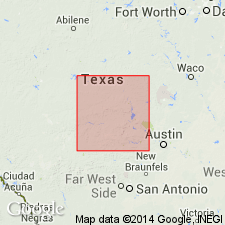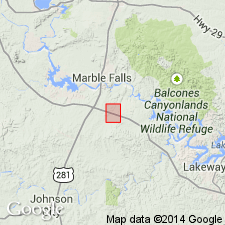
- Usage in publication:
-
- Espey Creek limestone member
- Modifications:
-
- Original reference
- Dominant lithology:
-
- Limestone
- AAPG geologic province:
-
- Bend arch
Summary:
Pg. 22, 26, 28. Espey Creek limestone member of Chappel limestone. Commonly made up of several layers of hard crystalline crinoidal limestone, each layer having a thickness from 3 to 8 or 10 inches; in many areas where member is not more than 1 foot thick, it consists of a single layer containing crinoidal debris or coquina somewhat loosely cemented and sparsely fossiliferous. Thickness ranges from 6 inches to 4 feet. Most persistent member of formation and is present almost everywhere along Barnett-Ellenburger contact. Chappel comprises [ascending] King Creek marl (new), Ives conglomerate, Espey Creek limestone, and Whites Crossing coquina (new) members.
Named from exposures along Espey Creek southeast of Hallenbeck ranch house, Lampasas Co., central TX.
Source: US geologic names lexicon (USGS Bull. 1200, p. 1285-1286).

- Usage in publication:
-
- Espey Creek limestone member
- Modifications:
-
- Overview
- AAPG geologic province:
-
- Bend arch
Summary:
Pg. 810 (footnote). Plummer's Espey Creek limestone member of Chappel formation is same as Chappel limestone of Sellard's (1933) and Cloud and Barnes (1948), excluding basal 15 inches referred by him to the Chappel at Espey Creek.
Source: US geologic names lexicon (USGS Bull. 1200, p. 1285-1286).
For more information, please contact Nancy Stamm, Geologic Names Committee Secretary.
Asterisk (*) indicates published by U.S. Geological Survey authors.
"No current usage" (†) implies that a name has been abandoned or has fallen into disuse. Former usage and, if known, replacement name given in parentheses ( ).
Slash (/) indicates name conflicts with nomenclatural guidelines (CSN, 1933; ACSN, 1961, 1970; NACSN, 1983, 2005, 2021). May be explained within brackets ([ ]).

